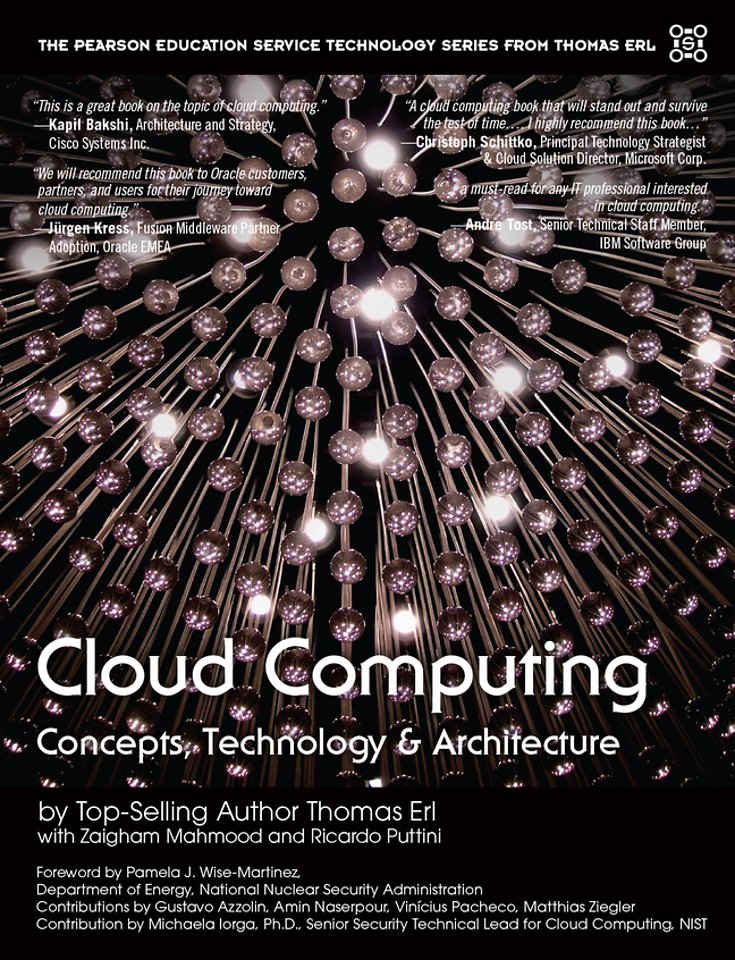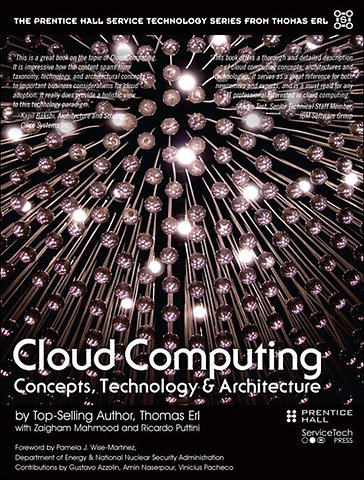



Thomas Erl is a top-selling IT author, founder of Arcitura Education Inc., and series editor of the Prentice Hall Service Technology Series from Thomas Erl.
Meer over de auteursCloud Computing
Concepts, Technology & Architecture
Samenvatting
Clouds are distributed technology platforms that leverage sophisticated technology innovations to provide highly scalable and resilient environments that can be remotely utilized by organizations in a multitude of powerful ways. To successfully build upon, integrate with, or even create a cloud environment requires an understanding of its common inner mechanics, architectural layers, and models, as well as an understanding of the business and economic factors that result from the adoption and real-world use of cloud-based services. In Cloud Computing: Concepts, Technology & Architecture, Thomas Erl, one of the world's top-selling IT authors, teams up with cloud computing experts and researchers to break down proven and mature cloud computing technologies and practices into a series of well-defined concepts, models, technology mechanisms, and technology architectures, all from an industry-centric and vendor-neutral point of view.
In doing so, the book establishes concrete, academic coverage with a focus on structure, clarity, and well-defined building blocks for mainstream cloud computing platforms and solutions. Subsequent to technology-centric coverage, the book proceeds to establish business-centric models and metrics that allow for the financial assessment of cloud-based IT resources and their comparison to those hosted on traditional IT enterprise premises. Also provided are templates and formulas for calculating SLA-related quality-of-service values and numerous explorations of the SaaS, PaaS, and IaaS delivery models.
With more than 260 figures, 29 architectural models, and 20 mechanisms, this indispensable guide provides a comprehensive education of cloud computing essentials that will never leave your side.
Specificaties
Inhoudsopgave
Acknowledgments
1. Introduction
1.1 Objectives of This Book
1.2 What This Book Does Not Cover
1.3 Who This Book Is For
1.4 How This Book Is Organized
1.5 Conventions
1.6 Additional Information
2. Case Study Background
2.1 Case Study #1: ATN
2.2 Case Study #2: DTGOV
2.3 Case Study #3: Innovartus Technologies Inc
PART I: FUNDAMENTAL CLOUD COMPUTING
3. Understanding Cloud Computing
3.1 Origins and Influences
3.2 Basic Concepts and Terminology
3.3 Goals and Benefits
3.4 Risks and Challenges
4. Fundamental Concepts and Models
4.1 Roles and Boundaries
4.2 Cloud Characteristics
4.3 Cloud Delivery Models
4.4 Cloud Deployment Models
5. Cloud-Enabling Technology
5.1 Broadband Networks and Internet Architecture
5.2 Data Center Technology
5.3 Virtualization Technology
5.4 Web Technology
5.5 Multitenant Technology
5.6 Service Technology
5.7 Case Study Example
6. Fundamental Cloud Security
6.1 Basic Terms and Concepts
6.2 Threat Agents
6.3 Cloud Security Threats
6.4 Additional Considerations
6.5 Case Study Example
PART 2: CLOUD COMPUTING MECHANISMS
7. Cloud Infrastructure Mechanisms
7.1 Logical Network Perimeter
7.2 Virtual Server
7.3 Cloud Storage Device
7.4 Cloud Usage Monitor
7.5 Resource Replication
7.6 Ready-Made Environment
8. Specialized Cloud Mechanisms
8.1 Automated Scaling Listener
8.2 Load Balancer
8.3 SLA Monitor
8.4 Pay-Per-Use Monitor
8.5 Audit Monitor
8.6 Failover System
8.7 Hypervisor
8.8 Resource Cluster
8.9 Multi-Device Broker
8.10 State Management Database
9. Cloud Management Mechanisms
9.1 Remote Administration System
9.2 Resource Management System
9.3 SLA Management System
9.4 Billing Management System
10. Cloud Security Mechanisms
10.1 Encryption
10.2 Hashing
10.3 Digital Signature
10.4 Public Key Infrastructure (PKI)
10.5 Identity and Access Management (IAM)
10.6 Single Sign-On (SSO)
10.7 Cloud-Based Security Groups
10.8 Hardened Virtual Server Images
PART 3: CLOUD COMPUTING ARCHITECTURE
11. Fundamental Cloud Architectures
11.1 Workload Distribution Architecture
11.2 Resource Pooling Architecture
11.3 Dynamic Scalability Architecture
11.4 Elastic Resource Capacity Architecture
11.5 Service Load Balancing Architecture
11.6 Cloud Bursting Architecture
11.7 Elastic Disk Provisioning Architecture
11.8 Redundant Storage Architecture
11.9 Case Study Example
12. Advanced Cloud Architectures
12.1 Hypervisor Clustering Architecture
12.2 Load Balanced Virtual Server Instances Architecture
12.3 Non-Disruptive Service Relocation Architecture
12.4 Zero Downtime Architecture
12.5 Cloud Balancing Architecture
12.6 Resource Reservation Architecture
12.7 Dynamic Failure Detection and Recovery Architecture
12.8 Bare-Metal Provisioning Architecture
12.9 Rapid Provisioning Architecture
12.10 Storage Workload Management Architecture
12.11 Case Study Example
13. Specialized Cloud Architectures
13.1 Direct I/O Access Architecture
13.2 Direct LUN Access Architecture
13.3 Dynamic Data Normalization Architecture
13.4 Elastic Network Capacity Architecture
13.5 Cross-Storage Device Vertical Tiering Architecture
13.6 Intra-Storage Device Vertical Data Tiering Architecture
13.7 Load Balanced Virtual Switches Architecture
13.8 Multipath Resource Access Architecture
13.9 Persistent Virtual Network Configuration Architecture
13.10 Redundant Physical Connection for Virtual Servers Architecture
13.11 Storage Maintenance Window Architecture
PART 4: WORKING WITH CLOUDS
14. Cloud Delivery Model Considerations
14.1 Cloud Delivery Models: The Cloud Provider Perspective
14.2 Cloud Delivery Models: The Cloud Consumer Perspective
14.3 Case Study Example
15. Cost Metrics and Pricing Models
15.1 Business Cost Metrics
15.2 Cloud Usage Cost Metrics
15.3 Cost Management Considerations
16. Service Quality Metrics and SLAs
16.1 Service Quality Metrics
16.2 Case Study Example
16.3 SLA Guidelines
16.4 Case Study Example
PART 5: APPENDICES
Appendix A: Case Study Conclusions
Appendix B: Industry Standards Organizations
Appendix C: Mapping Mechanisms to Characteristics
Appendix D: Data Center Facilities (TIA-942)
Appendix E: Emerging Technologies
Appendix F: Cloud Provisioning Contracts
Appendix G: Cloud Business Case Template
About the Authors
About the Foreword Contributor
About the Contributors
Index
Anderen die dit boek kochten, kochten ook
Rubrieken
- cadeauboeken
- computer en informatica
- economie
- filosofie
- flora en fauna
- geneeskunde
- geschiedenis
- gezondheid
- jeugd
- juridisch
- koken en eten
- kunst en cultuur
- literatuur en romans
- mens en maatschappij
- naslagwerken
- non-fictie informatief/professioneel
- paramedisch
- psychologie
- reizen
- religie
- schoolboeken
- spiritualiteit
- sport, hobby, lifestyle
- thrillers en spanning
- wetenschap en techniek
- woordenboeken en taal





